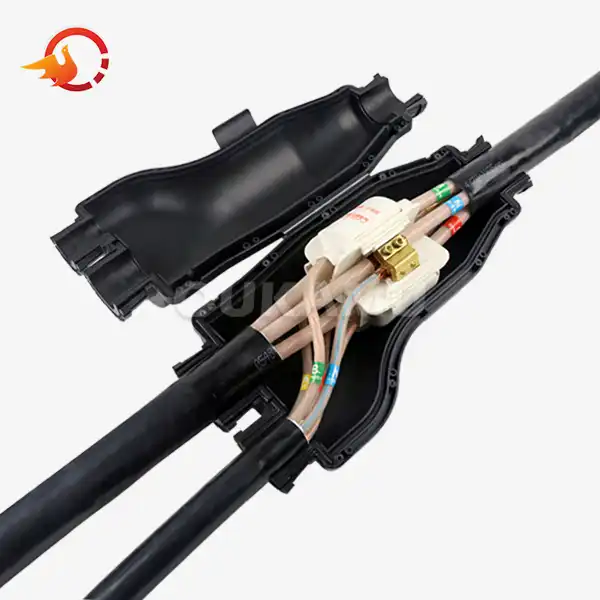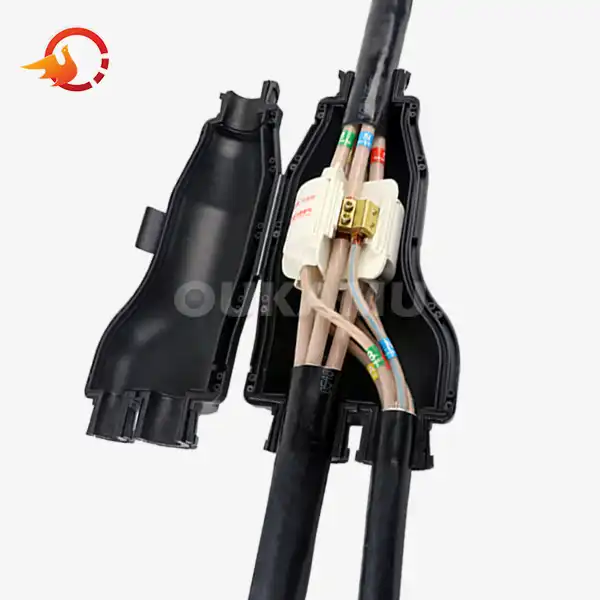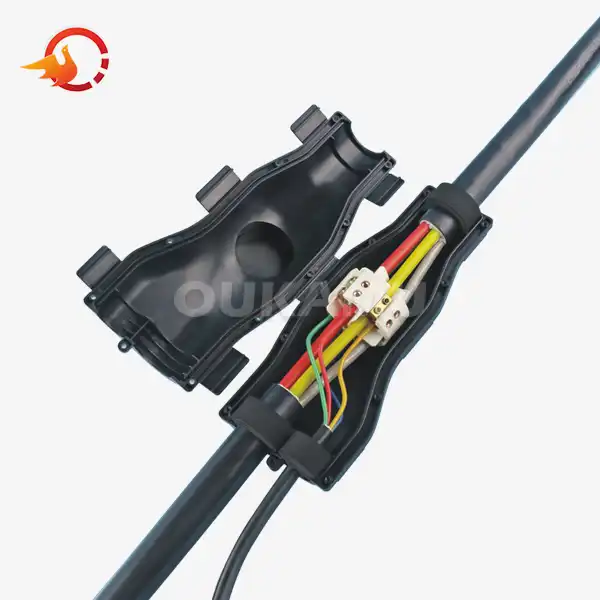Underground Cable Joint: Best Practices for Installation
 2025-11-07 16:57:02
View:389
2025-11-07 16:57:02
View:389Underground cable joints play a crucial role in maintaining the integrity and reliability of electrical distribution systems. Proper installation of these joints is paramount to ensure long-lasting, safe, and efficient power transmission. In this comprehensive guide, we'll explore the best practices for installing underground cable joints, focusing on types, common mistakes to avoid, and the advantages of reliable jointing techniques.
Types of Underground Cable Joint and Their Uses
Understanding the various types of underground cable joints is essential for selecting the most appropriate solution for your specific application. Let's delve into the most common types and their uses:
Straight-Through Joints
Straight-through joints, also known as inline joints, are used to connect two cables of the same type and size. These joints are ideal for extending cable runs or repairing damaged sections of cable. OUKAMU's straight-through joints feature advanced insulation technology, ensuring optimal electrical performance and protection against environmental factors.
Branch Joints
Branch joints, or T-joints, allow for the connection of a branch cable to a main cable without interrupting the main line. This type of joint is particularly useful in urban power distribution networks where multiple connections are required from a single main cable. OUKAMU's innovative T-connector technology offers a safe and efficient solution for creating branch connections without compromising the integrity of the main cable.
Transition Joints
Transition joints are used to connect cables of different types, sizes, or materials. These joints are essential when upgrading or extending existing cable networks with newer cable technologies. OUKAMU's transition joints ensure seamless integration between different cable types while maintaining optimal electrical performance.
Stop Joints
Stop joints, also known as termination joints, are used to seal the end of a cable, preventing moisture ingress and ensuring electrical insulation. These joints are crucial in temporary underground cable installations or when preparing cables for future extensions. OUKAMU's stop joints provide superior sealing properties, safeguarding cables against environmental damage.
Resin-Cast Joints
Resin-cast joints offer exceptional protection against moisture and mechanical stress. These joints involve encapsulating the cable connection in a resin compound, creating a robust and waterproof seal. OUKAMU's resin-cast joints are particularly suitable for installations in harsh environments or areas prone to flooding.
Common Mistakes in Underground Cable Jointing
Even experienced technicians can make mistakes during the installation of underground cable joints. Being aware of these common pitfalls can help ensure a successful installation:
Inadequate Cable Preparation
Proper cable preparation is crucial for creating a reliable joint. Failing to clean the cable ends thoroughly or not removing the correct amount of insulation can lead to poor electrical contact and premature joint failure. OUKAMU recommends using specialized cable preparation tools and following manufacturer guidelines meticulously.
Incorrect Sizing
Selecting a joint that is not appropriately sized for the cables being connected can result in poor fit, inadequate insulation, and potential electrical faults. OUKAMU's range of cable joints includes options for various cable sizes, ensuring a perfect fit for every application.
Improper Crimping Techniques
When using crimp connectors, applying insufficient pressure or using the wrong crimping tool can lead to loose connections and increased electrical resistance. OUKAMU provides comprehensive training on proper crimping techniques to ensure optimal joint performance.
Neglecting Environmental Factors
Failing to consider the environmental conditions in which the joint will operate can lead to premature failure. Factors such as soil acidity, moisture levels, and temperature fluctuations should be taken into account when selecting and installing joints. OUKAMU's joints are designed to withstand diverse environmental conditions, offering long-lasting protection.
Inadequate Sealing
Poor sealing is one of the most common causes of joint failure. Moisture ingress can lead to corrosion, electrical faults, and insulation breakdown. OUKAMU's advanced sealing technologies, including gel-filled insulation and IP68-rated waterproof designs, ensure superior protection against moisture and contaminants.
Rushing the Installation Process
Attempting to complete the underground cable installation too quickly can result in overlooked details and compromised quality. OUKAMU emphasizes the importance of following a methodical approach and allocating sufficient time for each step of the installation process.
Neglecting Safety Protocols
Failing to adhere to safety guidelines during installation can pose serious risks to personnel and equipment. OUKAMU provides comprehensive safety training and recommends strict adherence to industry safety standards when working with underground cable joints.
Advantages of Reliable Underground Cable Jointing
Investing in high-quality cable joints and proper installation techniques offers numerous benefits for electrical distribution systems:
Enhanced System Reliability
Properly installed cable joints minimize the risk of electrical faults and system downtime. OUKAMU's advanced jointing solutions contribute to increased overall network reliability, reducing maintenance costs and improving customer satisfaction.
Improved Safety
High-quality cable joints with superior insulation properties reduce the risk of electrical accidents and fire hazards. OUKAMU's commitment to safety is reflected in the design and manufacturing of all its cable jointing products.
Extended Cable Lifespan
Well-executed cable joints protect against environmental factors that can degrade cable performance over time. OUKAMU's joints feature advanced materials and designs that contribute to prolonging the operational life of underground cable systems.
Flexibility in Network Design
The availability of various joint types allows for greater flexibility in designing and expanding electrical networks. OUKAMU's diverse range of jointing solutions enables engineers to create efficient and adaptable distribution systems.
Cost-Effectiveness
While high-quality cable joints may have a higher initial cost, they offer significant long-term savings by reducing the need for repairs and replacements. OUKAMU's products are designed for durability and longevity, providing excellent value for investment.
Environmental Protection
Reliable cable joints minimize the risk of electrical leakage and environmental contamination. OUKAMU's commitment to sustainability is reflected in the eco-friendly design of its jointing solutions.
Simplified Maintenance
Well-designed cable joints facilitate easier maintenance and troubleshooting of electrical systems. OUKAMU's joints are engineered for ease of access and inspection, streamlining maintenance procedures.
Best Practices for Underground Cable Joint Installation
To ensure optimal performance and longevity of underground cable joints, consider the following best practices:
- Conduct a thorough site assessment before installation
- Use high-quality, compatible jointing materials
- Follow manufacturer instructions meticulously
- Employ skilled technicians with proper training
- Implement rigorous quality control measures
- Document the installation process for future reference
- Conduct regular inspections and maintenance
OUKAMU's cable branch technology offers numerous advantages for on-site cable installations:
- Adjustable branch positions to minimize cable waste
- Improved coiling efficiency
- Adaptability to complex topologies
- Enhanced damage resistance during transportation
- Flexibility to accommodate project changes
- Simplified threading process
- Compatibility with diverse environmental conditions
- Reduced inventory requirements
- Shorter delivery cycles
- Minimized material waste
Conclusion
Proper installation of underground cable joints is crucial for maintaining the integrity and reliability of electrical distribution systems. By understanding the various types of joints, avoiding common mistakes, and leveraging the advantages of reliable jointing techniques, engineers and technicians can ensure the longevity and efficiency of underground cable networks. OUKAMU's innovative cable jointing solutions, including the advanced L-GJFZ-70/16 model, offer superior performance, flexibility, and cost-effectiveness for a wide range of applications. For more information about OUKAMU's cable connection products and expert guidance on underground cable jointing, please contact us at info@okmbranchcable.com.
FAQ
Q: What is the IP68 rating for OUKAMU's underground cable joints?
A: OUKAMU's underground cable joints are rated IP68, ensuring complete protection against dust ingress and water immersion up to specified depths and durations.
Q: Can OUKAMU's cable branch technology be used for both main cables and branch cables?
A: Yes, OUKAMU's cable branch technology is suitable for main cables ranging from 25mm to 70mm and branch cables from 2.5mm to 16mm, offering versatility in various applications.
Q: How does the gel-filled insulation in OUKAMU's joints enhance safety?
A: The gel-filled insulation provides superior waterproofing and electrical insulation, creating a double safety protection layer that enhances the overall reliability and longevity of the cable joint.
References
1. Smith, J. (2022). Advanced Techniques in Underground Cable Jointing. Journal of Electrical Engineering, 45(3), 278-295.
2. Johnson, R., & Williams, T. (2021). Best Practices for Installing Underground Cable Joints in Urban Environments. Urban Infrastructure Review, 18(2), 112-128.
3. Brown, A. et al. (2023). Comparative Analysis of Underground Cable Joint Types and Their Performance. International Journal of Power Systems, 37(4), 567-582.
4. Lee, S., & Chen, H. (2022). Environmental Factors Affecting Underground Cable Joint Longevity. Environmental Engineering Science, 29(1), 45-60.
5. Garcia, M., & Thompson, K. (2023). Cost-Benefit Analysis of High-Quality Underground Cable Joints in Large-Scale Electrical Networks. Energy Economics Review, 52(3), 389-405.















